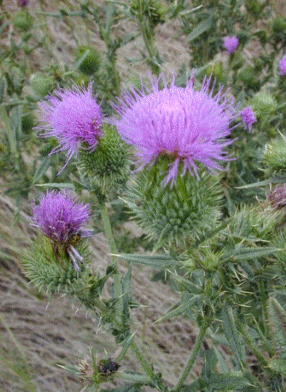 Bull Thistle
Bull Thistle
Noxious Weeds: Most Common: Bull Thistle and Specific Controls
Bull Thistle·
Description
Cirsium vulgare(Spear thistle, Bull thistle, Plumed thistle, Scotch thistle, Roadside thistle; syn. C. lanceolatum) is a species of the genus Cirsium, native throughout Europe, Asia and northern Africa, but also present in North America and Australia as an invasive weed. It is designated an "injurious weed" under the UK Weeds Act 1959 and a noxious weed in Australia and in nine US states.
Cirsium vulgare, Wagga Wagga, NSW, Australia
It is a tall biennial thistle, forming a rosette of leaves in the first year, and a flowering stem 1–2.5 m tall in the second year. The leaves are very spiny, deeply lobed, up to 15–25 cm long (smaller on the upper part of the flower stem). The inflorescence is 2.5–5 cm diameter, pink-purple, with all the florets of similar form (no division into disc and ray florets). The seeds are 5 mm long, with a downy pappus, which assists in wind dispersal
Specific Controls
Cultural Controls
Bull Thistle can be effectively controlled when treated with an approved herbicide before the flower stalks bolt. Hoeing or tillage will control Bull Thistle. If hand-digging, dig the root at least two inches below ground level and remove all soil. Repeated mowing of Bull Thistle will reduce seed production.
Chemical Controls
MSM - Late season thistle control where Sericea Lespedeza is also a problem.
Factors for Prevention and Control
For further information, contact the Weed Department.
Bull Thistle·
Description
Cirsium vulgare(Spear thistle, Bull thistle, Plumed thistle, Scotch thistle, Roadside thistle; syn. C. lanceolatum) is a species of the genus Cirsium, native throughout Europe, Asia and northern Africa, but also present in North America and Australia as an invasive weed. It is designated an "injurious weed" under the UK Weeds Act 1959 and a noxious weed in Australia and in nine US states.
Cirsium vulgare, Wagga Wagga, NSW, Australia
It is a tall biennial thistle, forming a rosette of leaves in the first year, and a flowering stem 1–2.5 m tall in the second year. The leaves are very spiny, deeply lobed, up to 15–25 cm long (smaller on the upper part of the flower stem). The inflorescence is 2.5–5 cm diameter, pink-purple, with all the florets of similar form (no division into disc and ray florets). The seeds are 5 mm long, with a downy pappus, which assists in wind dispersal
Specific Controls
Cultural Controls
Bull Thistle can be effectively controlled when treated with an approved herbicide before the flower stalks bolt. Hoeing or tillage will control Bull Thistle. If hand-digging, dig the root at least two inches below ground level and remove all soil. Repeated mowing of Bull Thistle will reduce seed production.
Chemical Controls
- 2,4-D Amine- 2.5 gallon containers.
- feedlots and waste areas
- pastures and CRP
- cool and warm season hay fields
- can be used as a tank mix with other products
- kills Bull & Musk Thistle and other broadleaves, but does not kill grass.
MSM - Late season thistle control where Sericea Lespedeza is also a problem.
- must be commercially applied
- for larger tracts
- kills Bull & Musk Thistle and other broadleaves, but does not kill grass.
Factors for Prevention and Control
- The first line of defense against bull thistle should be proper grazing management.
- Fertilization of cool-season forages is also an important practice in reducing a bull thistle invasion.
- Purchase feed gain or hay from reputable neighbors or dealers.
- Properly clean equipment before leaving an infested field.
- Apply herbicide(s) when bull thistle plants are in the rosette stage and rapidly growing with favorable soil moisture.
- For ground applications apply herbicide(s) with 10 to 20 gallons of carrier per acre.
- For aerial applications apply herbicide(s) with 3 to 5 gallons of carrier per acre.
- Retreat with the herbicide(s) or cultural treatment to prevent seed production and reduce new infestations.
For further information, contact the Weed Department.